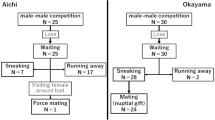Abstract
Two parapatric subspecies of the grasshopper Chorthippus parallelusform a hybrid zone in the Pyrenees. Partial assortative mating between subspecies must result from differences in elements of the sequence of behaviors that leads to mating. It was already known that the subspecies differ in the structure of the acoustic mating signal produced by males and in the amount of song produced under laboratory conditions. Here we investigate whether any differences exist in male mating strategies in the field, concentrating on the prediction that male C. p. erythropussing less and compensate for this by active searching (males divide their time between singing and moving in search of females). Results of field observations show that the two subspecies do in fact allocate their time differently. C. p. erythropusmales spend almost twice as much time moving around the habitat as C. p. parallelusmales. Furthermore, C. p. parallelusmales divide their time into long bouts of continuous singing alternating with periods of movement. C. p. erythropusmales, on the other hand, sing in short bursts interspersed with movement. The possible reasons for this divergence in male mating behavior and its consequences are discussed.
Similar content being viewed by others
References
Barton, N. H., and Hewitt, G. M. (1985). Analysis of hybrid zones.Annu. Rev. Ecol. Syst. 16: 113–148.
Broughton, W. B. (1976). Proposal for a new term “echeme” to replace “chirp” in animal acoustics.Physiol. Entomol. 1: 103–106.
Butlin, R. K. (1989). Reinforcement of premating isolation. In Otte, D., and Endler, J. A. (eds.),Speciation and Its Consequences, Sinauer Associates, Sunderland, MA, pp. 158–179.
Butlin, R. K., Ferris, C., Gosalvez, J., Hewitt, G. M. and Ritchie, M. G. 1992. Broad-scale mapping of a hybrid zone between subspecies ofChorthippus parallelus (Orthoptera: Acrididae).Ecol. Entomol. 17: 359–362.
Butlin, R. K., and Hewitt, G. M. (1985a). A hybrid zone betweenChorthippus parallelus parallelus andChorthippus parallelus erythropus (Orthoptera: Acrididae): Morphological and electrophoretic characters.Biol. J. Linn. Soc. 26: 269–285.
Butlin, R. K., and Hewitt, G. M. (1985b). A hybrid zone betweenChorthippus parallelus parallelus andChorthippus parallelus erythropus (Orthoptera: Acrididae): Behavioural characters.Biol. J. Linn. Soc. 26: 287–299.
Butlin, R. K., and Hewitt, G. M. (1986). The response of female grasshoppers to male song.Anim. Behav. 34: 1896–1899.
Butlin, R. K., and Ritchie, M. G. (1991). Variation in female mate preference across a grasshopper hybrid zone.J. Evol. Biol. 4: 227–240.
Butlin, R. K., Ritchie, M. G., and Hewitt, G. M. (1991). Comparisons among morphological characters and between localities in theChorthippus parallelus hybrid zone (Orthoptera: Acrididae).Phil. Trans. R. Soc. bond. B 334: 297–308.
Cade, W. H. (1975). Acoustically orienting parasitoids: Fly phonotaxis to cricket song.Science 190: 1312–1313.
Cade, W. H., and Cade, E. S. (1992). Male mating success, calling and searching behaviour at high and low densities in the field cricket,Gryllus Integer. Anim. Behav. 43: 49–56.
Helversen, D. von, and Helversen, O. von (1981). Korrespondez zwischen Gesang und auslosenden Schema bei feldeuschrecken.Nova Acta Leopold. 245: 449–462.
Hewitt, G. M. (1990). Divergence and speciation as viewed from an insect hybrid zone.Can. J. Zool. 68: 1701–1715.
Hewitt, G. M., Butlin, R. K., and East, T. M. (1987). Testicular dysfunction in hybrids between parapatric subspecies of the grasshopperChorthippus parallelus.Biol. J. Linn. Soc. 31: 25- 34.
Otte, D. (1977). Communication in Orthoptera. In Sebeok, T. A. (ed.),How Animals Communicate, Indiana University Press, Bloomington, pp. 334–361.
Perdeck, A. C. (1958). The isolating value of specific song patterns in two sibling species of grasshopper (Chorthippus brunneus Thun. andC. biguttulus L.).Behaviour 12: 1–75.
Prestwich, K. N., and Walker, T. J. (1981). Energetics of singing in crickets: Effect of temperature in three trilling species (Orthoptera: Gryllidae).J. Comp. Physiol. B 145: 199–212.
Ritchie, M. G. (1990). Are differences in song responsible for assortative mating between subspecies of the grasshopperChorthippus parallelus (Orthoptera: Acrididae)?Anim. Behav. 39: 685- 691.
Ritchie, M. G., Butlin, R. K., and Hewitt, G. M. (1989). Assortative mating across a hybrid zone inChorthippus parallelus (Orthoptera: Acrididae).J. Evol. Biol. 2: 339–352.
Tuttle, M., and Ryan, M. J. (1981). Bat predation and the evolution of frog vocalizations in the neotropics.Science 214: 677–678.
Walker, T. J. (1964). Experimental demonstration of a cat locating orthopteran prey by the prey's call.Fla. Entomol. 47: 163–165.
Author information
Authors and Affiliations
Rights and permissions
About this article
Cite this article
Neems, R.M., Butlin, R.K. Divergence in mate finding behavior between two subspecies of the meadow grasshopperChorthippus parallelus (Orthoptera: Acrididae). J Insect Behav 6, 421–430 (1993). https://doi.org/10.1007/BF01049522
Accepted:
Issue Date:
DOI: https://doi.org/10.1007/BF01049522




